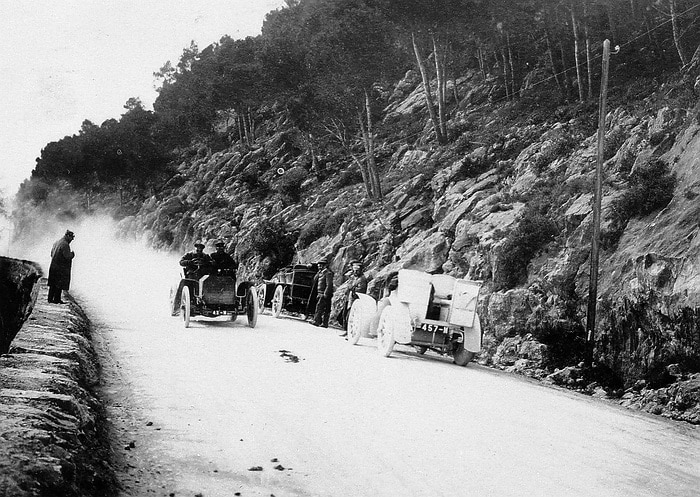Stuttgart. No car is faster or more successful: during the motor sport event “Nice Week” from 4 to 11 April 1902, the Mercedes-Simplex 40 hp proves itself far superior to the competition. At the Nice–La Turbie hill climb, the race car takes the first three places. Englishman E. T. Stead sets a new course record with an average of 55.2 km/h, followed by Albert “Georges” Lemaître and Wilhelm Werner in second and third place. Another triumph: in the mile race, Henri Degrais sets a new world record of 83.2 km/h for the mile with a standing start.
The figures document the level at which peak performance was defined 120 years ago: the speeds mentioned are epoch-making numbers – especially against the backdrop that they are achieved on public and unpaved roads. E. T. Stead and his colleagues are virtuosos at the wheel of the Mercedes-Simplex racing car with a four-cylinder engine – the best design at that time.
Luxury cars in the early days of the car
Shortly after the turn from the 19th to the 20th century, the Côte dʼAzur is the perfect place to present the new Mercedes Simplex 40 hp to the public. Here, the world’s beautiful, rich and powerful meet up in this mild climate to escape the sometimes grim winter of other places. In the midst of this wealthy society: businessman Emil Jellinek. He has been successfully selling Daimler-Motoren-Gesellschaft (DMG) vehicles in Nice for several years. The Mercedes 35 hp presented in 1901 owes its impulses to Bad Cannstatt – including the brand name. Even this first vehicle with the illustrious name is a great success in terms of performance and handling; it is considered the first modern car of all. Jellinek also initiated the improvements to the Mercedes-Simplex 40 hp. He perfectly combines enthusiasm for technology with business acumen and successfully positions DMGʼs outstanding products and the Mercedes brand in the international market, for example at “Nice Week”. These are important roots for the development of Mercedes-Benz, the worldʼs oldest luxury car manufacturer.
In the further development for the 1902 model year, the designers led by Wilhelm Maybach focused on a number of detail improvements that also benefited easier operation. This was reflected in the name of the new models, which were called “Mercedes-Simplex” in allusion to their ease of operation. At the same time, the model range is expanded: DMG launched three models in 1902, the Mercedes-Simplex 20 hp (4,084 cubic centimetres of displacement), 28 hp (5,322 cubic centimetres of displacement) and 40 hp (6,785 cubic centimetres of displacement). At that time, the model range did not yet differentiate between everyday and sport: with comparatively few modifications, for example, an open “tonneau” four-seater is turned into a two-seater racing car, which is then sent into sporting competition with the vehicles of other wealthy customers.
Pushing technical boundaries with performance and lightweight construction
The modifications compared to the Mercedes 35 hp are extensive: the engine of the 40 hp is enlarged in bore and stroke. The first vehicle has a displacement of 6,562 cubic centimetres, which is then increased again to 6,785 cubic centimetres (35 hp: 5,918 cubic centimetres of displacement). The two bottom-mounted camshafts are fully enclosed. For efficient cooling of the engine, which is completely covered at the bottom, the flywheel is also designed as a fan wheel and, with its suction effect, amplifies the airstream flowing through the cooler. The braking power is adjusted: additional band brakes act on the drive shafts of the sprockets and achieve the effect of differential locks at the same time through targeted individual actuation for right and left. The four brakes have water cooling that drips from a supply tank onto the friction surfaces during deceleration. The wheelbase is extended from 2,245 millimetres to 2,450 millimetres compared to the predecessor model.
The reduced total weight of the Mercedes-Simplex 40 hp of 943 kilograms is also remarkable. By comparison, in 1900, the Phoenix 23 hp racing car still weighed 1,400 kilograms, and the Mercedes 35 hp weighed 1,112 kilograms in 1901. The engine alone weighs 46 kilograms less (40 hp: 185 kilograms; 35 hp: 231 kilograms).
Sporting successes make the brand known worldwide
After the successes at the “Nice Week”, the Mercedes-Simplex 40 hp also wins in other competitions. Wilhelm Werner won the Semmering race in September 1902 ahead of the previous yearʼs winner, Dr Richard Ritter von Stern. DMGʼs top model also demonstrated its speed in record runs on public roads, whose surfaces were anything but ideal at the time: American billionaire William K. Vanderbilt II staged a record-breaking attempt in his Mercedes-Simplex 40 hp on the road from Ablis to Chartres in May 1902, reaching a speed of 111.8 km/h. In the Oostende kilometre race in July, Baron Pierre de Caters even reaches 120.8 km/h with the Mercedes-Simplex 40 hp.
The Mercedes-Simplex brings the car with a combustion engine to the forefront of the competition between the drive technologies of that time. A passion for innovation, visionary drive and technical creativity shaped the “Mercédès era”, as this groundbreaking age came to be known. There is a parallel here to today: in the current upheaval of the automotive industry, Mercedes-Benz is once again using the same values to drive the future of individual mobility with digitalised, connected and electrically powered vehicles.











